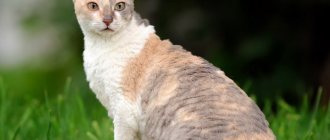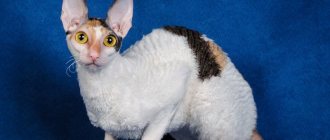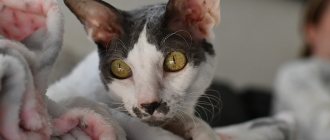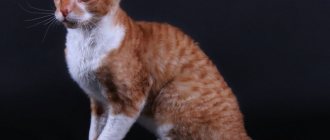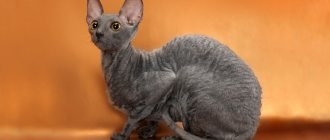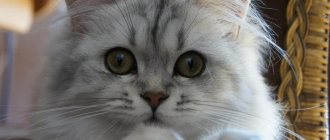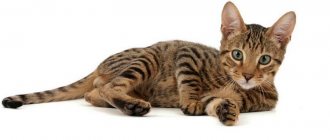Brief history of the breed
In the first half of the 20th century, an unusual curly-haired kitten was spotted near one of the Berlin hospitals. But then no one paid enough attention to him. The world learned about the existence of the Cornish Rex later.
The official history of the breed began in July 1950, when a kitten with curly fur was born in Cornwall on Nina Ennismore's farm. The baby with huge ears on a wedge-shaped head looked very much like an alien creature. Therefore, the owner came up with an original nickname for him - Kalinbooker.
A few months later, the farmer decided to castrate the unusual pet. But when she came to the veterinarian, he convinced her that the curly-haired male could become the founder of a new breed of cats. Ennismore bred Kalinbooker with his own mother, Serena, resulting in three kittens. Two of the newborns inherited their father's curly fur. True, one of them soon died.
The one who survived received the nickname Poldu and later took part in Nina Ennismore's experiments. In each litter resulting from crossing Serena with her own son and grandson, half of the kittens had curly fur. This only confirmed the recessive type of inheritance of the curly gene. A few years later, Ennismore began to have serious financial difficulties, and she stopped her experiments - Serena and curly-haired Kalinbooker were euthanized.
Poldu escaped the same fate only because Stirling Webb bought him out. But due to a coincidence, the curly-haired cat was neutered. Fortunately, he managed to leave behind several descendants with the curly gene.
In 1957, two Cornish Rex dogs were purchased by Frances Blanchery and taken to the USA. The red, curly male did not leave any offspring. But the female with a blue and white coat turned out to be pregnant. In due time, she gave birth to two curly-haired kittens, from which numerous breed branches in America emerged.
Subsequently, Cornish Rex dogs began to be bred with Siamese, Burmese and representatives of other short-haired breeds. As a result of the influx of foreign blood, curly cats acquired a wider color palette and became even more popular. In 1983, the breed received official recognition.
Find out how the Cornish Rex differs from the Devon Rex.
Breeding
Those who want to start breeding this breed should find a partner in advance.
This may take several months, depending on where you live. In big cities this is easier and faster. This breed is still considered rare and has some peculiarities in its reproduction. Females become sexually mature at 9 months, but there is no need to rush. The animal’s body must become stronger and its hormonal levels must return to normal. The first mating is best done after a year. This applies to females and males. A categorically important condition for breeding a breed is a complete ban on the use of other cat breeds for these purposes. There is a risk of losing the gene that is responsible for the main characteristics of the breed - a special curly coat, ear shape and body type.
Mating and pregnancy of cats
Both animals must be in good health, have the necessary documents and vaccinations for the animal. The animal must be active, without signs of disease. In this case, the likelihood of getting healthy offspring increases significantly. The most important factors in choosing a partner are:
- pedigree of the animal;
- health;
- experience from previous matings.
Before mating, the animal must be treated for worms; it is recommended to trim its claws. The mating itself is carried out in the cat’s territory, and it is advisable for the cat to stay in this place for 3-5 days so that they get used to each other.
Unusual Cornish Rex with heterochromia.
Pregnancy lasts about two months – 63-65 days. If your health is good and there are no problems, childbirth is quick and easy. The approach of childbirth can be recognized by the behavior of the animal - the female begins to look for a quiet, secluded place for herself. The weight of kittens at birth is 100-110g. A cat brings up to 5 kittens per lamb. Newborn kittens have curly fur, but after a week it straightens. Curls begin to appear after the first molt.
Interesting Facts
Since the advent of the Cornish Rex, a lot of interesting things have happened with curly-haired cats:
- The history of this breed could begin much earlier. But in the old days, kittens with curly hair were mistaken for scab patients and killed.
- The farm where Kalinbooker appeared specialized in breeding curly-haired rabbits.
- Cornish Rex cats are highly sensitive to anesthetics. Therefore, curly-haired cats tolerate anesthesia much harder and often show an unpredictable reaction to the most common medications.
How much does a kitten cost and how to choose one?
A kitten in Russia costs from 15,000 to 20,000 rubles, if it is a pet-class cat. A “show class” kitten will cost 25 – 60,000 rubles and more. You can find a kitten on the Internet, at exhibitions, and also in nurseries - they are in almost every major city. Nurseries often post advertisements on sites such as Avito. Therefore, if you decide to buy a kitten based on an advertisement from a nursery, you should call and clarify the information. You should choose a kitten based on photographs and descriptions of its parents, as well as after checking all the documents available for it: metrics, pedigree, vaccination card.
Cornish Rexes are sweet and graceful creatures, very elegant and aristocratic. They are ideal for active young people who love walks and active games. These cats do not need any special care or a strict diet; they have excellent health and good manners. If you need an affectionate and friendly friend who understands you at a glance, choose a Cornish Rex and you will live happily ever after.
Breed description, standards, appearance
Cornish Rexes are sophisticated, graceful cats with strong bones, well-developed muscles and curly, velvety hair. Representatives of the breed are divided into two types - European and American. Moreover, the latter look lighter and more sophisticated. A detailed description of the Cornish Rex breed is available in the generally accepted standard.
Dimensions and weight
Cornish Rexes are a small to medium sized breed. The weight of an adult curly cat reaches 3-4 kg. The cat's weight is 4-5 kg.
Anatomical characteristics
According to the standard, a Cornish Rex cat must meet the following description:
- Representatives of the American line have an ovoid head. In the European-type Cornish Rex it looks more like a triangle. The forehead is rounded, the cheekbones are high and clearly defined. The stop is moderately pronounced or completely flat.
- The ears are cone-shaped, set far apart, with a wide base and rounded tips.
- The eyes are medium or large in size, oval, obliquely set. The iris of the Cornish Rex is in harmony with the coat color.
- The body is slender, elongated, with a strong, moderately wide chest, an elegant muscular neck, a toned stomach and a curved “arched” back.
- The limbs are long, thin, with developed muscles, oval paws and long fingers.
- The tail is flexible, mobile, whip-like.
Read more about curly cat breeds in this article.
Color and coat type
The body of the Cornish Rex is covered with a soft, silky coat. Despite the absence of a strong spine, the cat's curly fur is pressed tightly against the body and lies in uniform waves. On the belly, chest and chin of the animal, the hair is slightly shorter than on other parts of the body.
Important! The Cornish Rex is not shaggy. A long-haired kitten with curly fur, at best, will turn out to be a representative of another breed, at worst, a mestizo of unknown origin.
According to the standard, the Cornish Rex can have almost any color. The following options are especially popular:
- ginger;
- red;
- tortoiseshell;
- mink;
- cream;
- blue point;
- lilac;
- Siamese;
- white;
- black;
- tabby;
- blue (gray).
On a note. Representatives of the Cornish Rex breed with color-point color have blue eyes. In snow-white individuals, the iris is colored blue or golden. If the Cornish Rex is completely black, its eyes should only be golden.
Possible breed defects
Exterior defects, if present, Cornish Rex cats will not receive a high exhibition rating:
- small ears;
- bald patches on curly hair;
- wide or too long head;
- massive or stocky body;
- sparse coat;
- short, hairless or excessively furry tail.
According to the breed standard, Cornish Rexes are subject to disqualification:
- with pronounced kinks in the tail;
- atypical number of fingers;
- rough spine;
- insufficiently velvety coat;
- amputated claws;
- deafness;
- lameness;
- cryptorchidism.
Breed standard
Rex cats should have strong muscles, an elongated and slender body, fairly strong hips, powerful rump and shoulders. The arched curve of the Cornish's back is noticeable even when the cat is just standing.
How long do cats live at home?
The Cornish cat's legs are long and slender, and its paws have five toes in front and four in back. The head is small, oval, with smooth curves, but chiseled cheekbones and a firm chin. The tail is flexible, thin and long.
The most important feature of the breed is its coat. It is soft, short and curls in waves. There are no guard hairs. Curls become especially noticeable on the underside of the chin, on the abdomen and chest.
Possible colors:
- white;
- black;
- blue;
- red;
- cream;
Important! The wool should be colored evenly, without tints, other shades or patterns.
Character and temperament
The Cornish cat has a kind and affectionate disposition. She becomes very attached to people and does not like to be alone for a long time. In the absence of proper attention, the curly cat begins to feel sad.
On a note. The Cornish Rex cat breed is not suitable for people who are not at home much. Left to its own devices, the animal begins to amuse itself by damaging the owner's property.
Cornish Rexes will never harm babies. These curly-haired cats get along well with children and enjoy playing together. However, if kids drag the Cornish by the tail, the animals will begin to perceive them as a potential threat and will try to avoid contact with the little offenders.
Representatives of the curly breed quickly find a common language with other cats and dogs. But if they are not given enough attention, they begin to get jealous and pointedly ignore their household members.
Important! Cornish Rexes have well-developed hunting instincts. Therefore, it is not recommended to keep cats of this breed together with ornamental birds, small rodents and aquarium inhabitants.
Character
The Cornish cat is an intelligent, active and playful creature. The beast explores every corner of the apartment and will climb everywhere, especially where the cat’s paw should not go. Thanks to its high intelligence, a kitten can even learn to bring a ball to its owner, but it will only do this when it wants to.
How long do castrated cats live at home: lifespan
Such a pet will happily lie on your lap and spend a lot of time with a person. He is also friendly to other pets.
Cornish is a typical homebody who is unlikely to want to escape into the street through a randomly opened door. They do not like to change their usual environment; after moving to a new apartment, kittens may even meow in bewilderment for several days. This lasts from a week to a month; new owners have nothing to worry about, since this behavior is quite natural.
Note! Corniches are quite talkative, they have a peculiar thin voice. The kitty doesn’t mind using it at any time when she needs something from her owner.
How to choose the right kitten
The Cornish Rex is no less common and popular breed than the Siamese, Scottish Fold or British. Therefore, there are usually no problems with finding a kitten, especially if you contact trusted breeders or certified nurseries.
When choosing a small Cornish, you should pay attention to the following nuances:
- availability of pedigree and veterinary passport;
- health status;
- conditions of detention;
- behavioral characteristics;
- compliance with the breed standard.
Important! If the kitten does not take part in games with littermates and looks unhealthy, it is better not to buy it.
Kitten care
Until the age of three months, a Cornish Rex kitten needs maternal care and cannot live independently. During this period, he receives his first vaccinations and learns basic things. Therefore, competent breeders begin to distribute curly-haired babies after they are 12 weeks old. This means that potential owners have enough time to prepare for the pet’s arrival.
To make the Cornish Rex kitten comfortable, they buy him:
- bed or house;
- tray and filler;
- carrying;
- toys;
- scratching post;
- a set of bowls for food and water;
- hygienic cosmetics (shampoos, lotions, etc.);
- grooming tools (toothbrushes, combs, nail clippers, etc.).
Important! For the sake of safety, decorative plants, electrical wires, household chemicals, medicines, small and fragile objects are removed from the little Cornish Rex.
To make it easier for the kitten to adapt to changed conditions, you can ask the breeder for any item with the smell of its native “nest”. And so that the little Cornish Rex gets used to the hands and his own nickname, he is often petted and called by name.
On a note. For a Cornish Rex kitten, it is better to choose an original short and easy to remember nickname. Suitable names for the cat include Abby, Kylie, Molly or Shayna. The cat can be called Shrek, Erwin, Noir or Wolf.
What to name a Cornish Rex
Many breeders claim that the pet’s future behavior depends on its name. Therefore, below are several examples of nicknames that you can assign to your pet.
The most suitable names for cats are: Abu, Archie, Bucks, Best, Waltz, Wolf, Harold, Denis, Dior, Jacques, Zephyr, Izya, Yoshi, Cupcake, Clif, Coconut, Leo, Larick, Major, Maurice, Neon, Oscar , Twin and others.
For cats: Amira, Asya, Basya, Belka, Bonya, Haze, Drop, Note, Ollie, Pepsi, Polly, Runa, Tata, Beans, Chloe, Chili, Cherry, Chanel, Sheela, Utah and others.
Care and maintenance
The Cornish Rex's coat does not retain heat well. Therefore, they will be comfortable in a bright, spacious room in which the air temperature is maintained at 20-22 degrees.
Otherwise, caring for cats of this breed comes down to maintaining a neat appearance using standard hygiene procedures:
- The Cornish Rex's eyes and ears are regularly inspected for the presence of non-specific discharge and carefully wiped with cotton pads soaked in herbal infusions or alcohol-free lotions.
- The teeth of cats of this breed are cleaned 2-3 times a week with a non-foaming toothpaste and a soft brush or silicone brush. This simple procedure will not only help remove unsightly plaque from Cornish Rex fangs, but also prevent the development of dental diseases.
- To avoid damage to wallpaper and furniture upholstery, be sure to trim your cat's claws 2-3 times a month. They do this very carefully so as not to touch the blood vessels.
- Due to the lack of thick hair, the skin of the Cornish Rex constantly accumulates secretions and sweat, which must be washed off regularly. Cats of this breed are given bath treatments approximately once a week. To ensure that the Cornish Rex's coat remains silky, they are washed using mild shampoos.
- Cats of this breed are not predisposed to frequent and heavy shedding. Therefore, they do not need to be combed out with special brushes. To keep the curly coat of the Cornish Rex looking well-groomed, it is enough to periodically treat it with damp suede.
Care, maintenance and nutrition of the Cornish Rex
The life of this breed is practically no different from other pets. Cornish Rexes need the same care procedures, the creation of suitable conditions for a full-fledged existence, and the inclusion of the right food and fresh food in their diet. Only in this case will a cat of this breed enjoy the company and its life in general. In addition, it is important for his health.
Cornish Rex - how to care?
Creating suitable conditions is important for the life of any animal. Corniches need the following types of care:
- Grooming
. It is important to do everything carefully so as not to damage the hair structure while combing. Only brushes with natural bristles can be used for this procedure. - Nail care
. The Cornish Rex kitten naturally has small paw pads, so the claws are not completely hidden. To give an elegant look and prevent others from scratching, it is recommended to trim them every month. A similar procedure is carried out using a medium-sized nail clipper. - Eye care
. If necessary, wipe the eyes with damp cotton wool. Boiled water, eye hygiene solution or coconut oil are used as a solution. - Ear care
. Due to their large size, not only wax, but also dust and dirt accumulate in the ears, so you need to clean them as needed. For cleansing, use cotton swabs treated with a special solution or coconut oil. - Cornish Rex bathing
. Short hair does not have the ability to absorb sebaceous secretions, so the animal needs to be bathed. Take warm water with the addition of cat shampoo. Soaping is carried out in the direction of hair growth. Excess moisture is removed with a towel and then allowed to dry.
What to feed your Cornish Rex?
The diet of cats of any breed is based on their age. The Cornish Rex cat is switched to an adult diet from the age of three months. You can feed your cats regular food or special premium food, such as Pro Plan or Royal Canin. The breed has an excessive appetite, and in order to prevent excess weight gain and gastrointestinal problems, it is recommended to feed the pet only on a two-meal schedule. All food should be chopped into small pieces. Having chosen to feed natural products, you need to know what you can give and what you should refuse. Allowed:
- frozen dietary meat;
- offal;
- cereals;
- vegetables;
- eggs;
- dairy products;
- sprouted grains;
- grass.
Forbidden:
- fish;
- cow's milk.
It is important not to forget that 80% of the daily diet of this pet should consist of meat dishes; these can be offal, which must be thoroughly boiled and cut into oblong strips. Regardless of what diet is chosen, it is necessary that the pet has free access to clean, filtered water in large quantities.
Cornish Rex diseases
Animals of this breed have good health and strong immunity. Sometimes problems appear in entire genetic lines. Cats are susceptible to specific diseases:
- Hypothyroidism
. Appears when there is a lack of thyroid hormones leading to damage to the skin and coat, as well as appetite disturbances. - Hypotrichosis
. Cause of hair loss. The problem does not cause any harm to life or health, but is only cosmetic. - Hypokalemia
is a genetic problem. It is a lack of potassium. - Progressive retinal atrophy
. The problem can only be determined by examination by an ophthalmologist. - Alopecia
. Appears at birth in the form of a fluff on the skin, which disappears without sprouting hair. Such problems with the coat of the Cornish Rex are extremely rare.
Good health does not exempt pets from mandatory vaccinations. 10 days before the start of the course, the worms are treated. Vaccinations for the Cornish Rex breed are as follows:
- At two months
– against infections. Revaccination after 4 weeks. - At three months
- from rabies. - At four months
– against fungal diseases. Revaccination in a week.
Cornish Rex - pregnancy and childbirth
Sexual maturity in cats begins at the age of 6-9 months. However, experts recommend starting mating only from the age of one, because only at this time the body is fully formed and ready for reproduction. Pregnancy lasts up to 66 days, during which time the cat is fed 2-3 tablets of Kitzim vitamins daily. Childbirth is easy and does not cause concern. You can learn about their approach by their behavior; the animal will look for a secluded place. Normally, childbirth takes one day, starting with the appearance of discharge. Cornish Rex kittens appear with thick, wavy fur.
Feeding the cat
Many experts recommend giving Cornish Rex dogs premium or super premium drying. When choosing food for curly-haired cats, it is advisable to pay attention to its composition and expiration dates.
It is important to remember that the main characteristic of any high-quality drying is the absence of wheat, corn, soy, dyes and preservatives.
Cornish Rex eat the following brands of food with appetite:
- Hills;
- Grandorf;
- Pronature;
- Monge.
If the diet of curly-haired cats consists of natural products, then lean varieties of meat should predominate in it. Cornish Rex cats are also given ocean fish, vegetables, cereals, sour milk and quail eggs.
To maintain the health of a purebred pet, fatty meat, river fish, fresh milk, sweets, baked goods, sausages, smoked meats, pickles and any leftovers from the master’s table are excluded from its menu.
Cornish Rex cats are highly active and have an excellent appetite. They are constantly hungry, and if you overfeed them, they will quickly gain excess weight. And a fat pet runs the risk of acquiring a whole “bouquet” of diseases over time.
How to care?
To maintain the beauty of the Cornish, you should wash it twice a month. You should start accustoming your kitten to water procedures at about 16 weeks. You need to wash your cat using massaging movements along the hair growth. The water temperature should be approximately 38 degrees. After bathing, the coat should be soaked with a towel, but not dried. If the animal is not afraid of a hair dryer, then you can dry it on a warm setting. Natural citrus oils are used to create a “doodle” on the wool.
Brushing Cornish cats is often not recommended, as cats of this breed do not shed. When combing, use a mitten or a brush with natural bristles so as not to harm the animal’s fine fur.
Cornish cats have their nails trimmed without fail. In cats they are quite sharp, in this case you have to constantly ensure that the cat does not damage the furniture or accidentally leave “scratches” on family members
You need to trim the claws very carefully, only 1-2 millimeters of the transparent part of the claw
It is necessary to cut with a special nail clipper (its size should be medium)
Before the procedure, it is important to treat the instrument with cotton wool with alcohol or an alcohol wipe, then, after cutting the claw, file it, giving it a rounded shape. Some breeders use natural cosmetic oil for nails; it protects the cat’s claws from peeling and moisturizes them.
Check your cat's teeth weekly and visit a veterinarian if necessary. Caring for your cat's teeth should be done daily. You can wipe your teeth with plantain infusion, wrapping gauze around your finger, or brush your teeth with a rubber thimble. You can also buy toothpaste or a special toy for cleaning teeth in specialized stores for animals. Remember to include solid foods that are good for your teeth in your diet.
For eye care, it is recommended to use plain boiled water and chamomile infusion once a week (the eyes are treated to prevent infectious diseases). Rex ears require constant care. In order to clean them, you need to use Vaseline or special caring drops (clean them with a cotton swab). It is necessary to monitor your pet's ears in order to prevent ear diseases in time.
List of necessary items for caring for a Cornish Rex:
- cat shampoo;
- nail clipper;
- cotton pads and sticks;
- petrolatum;
- special toothpaste and brush for cleaning the animal’s teeth;
- powder for cleaning wool;
- dry shampoo for cleaning wool.
Education and physical activity
Cornish Rexes are easy to train. Smart and quick-witted cats quickly remember not only the rules of behavior in the house, but also some “dog” commands. If desired, they can be taught to walk on a leash, fetch thrown objects and give a paw.
Active and energetic, Cornish Rex cats retain a sense of adventure until old age. Cats of this breed love to jump, play and climb on cabinets. To redirect the Cornish Rex's energy in the right direction, they are given a lot of toys, balls and a sports complex with shelves, tunnels and a scratching post.
Description
Cats of this breed have a narrow skeletal structure; small body; the torso is elongated; the back resembles an arc; long limbs; flexible tail; the head is small, wedge-shaped; the Roman nose has a clear bridge; almond-shaped eyes. The main feature is astrakhan fur. Thick and wavy, it curls all over the body. Having no guard hairs, it feels very thick, soft and velvety to the touch. Cats weigh no more than 3 kg, males up to 4.5 kg.
These cats are so sociable that it is very difficult to tolerate loneliness. They become attached exclusively to one owner. Having a developed intelligence and good-natured character, they are easy to train and learn. These animals have a lot of energy that constantly requires release; they never get bored. These pets are not aggressive, do not mark boundaries, and do not steal food from the table. They are aristocrats from the tips of their ears to the tips of their claws.
Health and susceptibility to disease
With proper care and a high level of activity, Cornish Rex dogs can live up to 14-15 years. Despite strong immunity and good heredity, cats of this breed still have health problems.
Cornish Rex dogs have a predisposition to:
- to solar dermatosis;
- hypotrichosis;
- retinal atrophy;
- hypoglycemia.
Nutrition
Cats of this breed are not picky eaters. Like any animal, they require a normal balanced diet to function normally. The presence of vitamins and minerals is the key to the normal development of muscles, skeleton and a healthy appearance of the cat’s skin.
Active and energetic games require a lot of effort. Cornish Rex are always hungry. They can eat up to five times a day. But, it is worth accustoming them to eating at the same time in the morning and in the evening, otherwise very soon they will gain excess weight.
Of course, the owner will decide what the Cornish Rex will feed on. Selecting a diet from natural products or dry balanced food is a controversial issue. Nutritionists consider a mixed diet not advisable, since different amounts of enzymes are needed during the digestion of different foods. Although veterinarians and breeders consider mixed feeding to be the most optimal.
To select a menu made from natural products, it is worth including:
- Chicken meat;
- White fish;
- Vegetables;
- Cereal porridge;
- Cottage cheese, unsalted cheese, kefir;
- Boiled eggs, liver.
Important: If a male lives in the house, you should give up fish and seafood in your diet. Their consumption can lead to the formation of sand and kidney stones. Accordingly, problems with the kidneys and urinary tract.
If you take good care of your cat and choose the right diet, the Cornish Rex can live up to twenty years. On average, the lifespan of wavy cats is 14-15 years.
Vaccinations and antiparasitic treatment
To prevent the curly-haired cat from becoming a victim of standard infections, she is vaccinated against panleukopenia, calcivirosis, rabies and rhinotracheitis. The first vaccination for a Cornish Rex kitten is given at 7-8 weeks with a mandatory repeat after 28 days. Subsequently, a cat of this breed is vaccinated once a year.
To prevent diseases transmitted by fleas and worms, the Cornish Rex is regularly sanitized. Anthelmintic drugs are given to the cat twice a year, repeated every 10-14 days. To get rid of fleas, the Cornish Rex's fur is treated with special drops or shampoos.
Breeding Basics
Puberty in representatives of the breed occurs closer to 7–9 months, but at this time the animal is not yet ready, either mentally or physically, for the first mating. Therefore, it is necessary to look for a suitable partner closer to the pet reaching one year of age, when the cat is already able to bear and give birth to healthy offspring without physical abnormalities.
Pregnancy in pets lasts from 63 to 66 days and, as a rule, proceeds normally, but much depends on the health of the expectant mother. Sometimes vitamin supplements or medications may be needed to make her feel better. It is not recommended to knit a cat too often (about twice a year). Childbirth and feeding of offspring exhausts the animal, leading to various diseases and stress.
Crossing nuances:
- when choosing a bride or groom, you should evaluate their health: check for vaccinations, examine the animal for treatment against fleas and worms, ask the owner for a certificate of absence of infectious diseases;
- one of the partners must be previously untied, only in this way the process will be crowned with success;
- the crossed individuals should not be closely related;
- vaccinations must be done about a month before mating; vaccination on the eve of mating can lead to abnormalities in the offspring;
- the pet should be left next to the male for a period of 3 to 6 days, usually fertilization occurs on the 4-5th day with a seven-day duration of estrus;
- both partners must first trim their claws to avoid injury;
- Mating should be carried out on the territory of the male.
It should be noted that breeding Cornish Rexes with representatives of other breeds is strictly prohibited. Such a union can provoke the birth of unhealthy and non-viable offspring.
Pros and cons of the breed
Reviews from owners indicate that Cornish Rexes are almost ideal pets. But before buying a curly cat, it is better to independently analyze all the advantages and disadvantages of the breed:
| pros | Minuses |
| Unusual appearance | Increased activity |
| Lack of excessive shedding | Drug sensitivity |
| Contact | Intolerance of loneliness |
Cornish Rexes are cats with a velvety curly coat and large ears. The original appearance of these graceful animals is complemented by a playful and sociable disposition, which makes them ideal companions for both large families and lonely homebodies.
What breeds are there?
As already mentioned, there are several varieties of Rex: German, Dutch, Bohemian, Devon Rex and Cornish Rex. Let's take a closer look at each type.
German
The German Rex is a playful and affectionate animal, differing from its counterparts in its fur. His hair is wavy and velvety. The coat color and pattern of a German can be absolutely any. Such a cat has an elegant body, medium size and a round head. The ears are small and neat, the eyes are almond-shaped, and the cheeks are prominent. The German Rex breed appeared in Germany randomly in the 1950s and 60s, and it is still not known for certain where the breed of curly-haired cats came from in this country.
Dutch
The Dutch Rex breed differs from others in its short and hard, curly hair. According to the description, this cat has a small head, large ears, long legs and a graceful body. The coat curls over the body in small, stiff curls or short waves. As with the German Rex, the color and pattern of the coat can be any.
Bohemian
The Bohemian Rex is a very interesting and aristocratic variety of Rex. Its main difference is its long and thick wavy coat. The breed appeared in Czechoslovakia in the 80s of the last century, when a pair of Persian cats gave birth to kittens with curly long hair. Bohemians have fluffy soft fur, neat ears and paws, a wide and short neck, rounded cheeks and a clear, strong chin. Looking at such a cat, there is no doubt that this is a special breed.
Devon Rex
Devon Rex cats are native to Great Britain. They are loving, lively and extremely friendly.
Devon Rexes have an interesting appearance - in addition to short soft curly hair, they attract attention with a round head, large ears, thin neck, long body and legs. This cat is elegant and graceful, at the same time very playful and loves to run and jump, unlike, for example, the Scottish breed
Devon Rex coat colors can be any color, the most common being solid black, white, grey, tortoiseshell point, bicolor and cinnamon.
Cornish Rex
This is an amazing and beautiful breed of cat. Their fur looks like a soft astrakhan fur coat with neat, clear curls. This breed is divided into American and European, the differences between them are only in the curve of the back and the shape of the head. The European Cornish has a straight back and a round head with relatively small ears. The American breed has an arched back and a small, pointed head.
Cornish kittens are friendly and loving. They get along easily with children and love outdoor games and walks. And they cannot stand loneliness at all, so Rexes are not suitable for those people who are often not at home.
Health
The painstaking work of breeders helped create a breed with good health and virtually no genetic diseases. Diseases such as hypokalemia (potassium deficiency), retinal atrophy, and alopecia occur quite rarely.
The Cornish Rex is not immune to colds, fleas and worms, vomiting and diarrhea and other common diseases that any cat can catch.
It is recommended to remove internal parasites every three months. Regularly inspect your pet's fur to detect the presence of fleas in time. By avoiding drafts and prolonged hypothermia, you can protect your pet from colds. And by removing poisonous indoor plants from your apartment that your cat can chew, you will protect her from poisoning.
Character of the breed
The happy owners of such cats do not skimp on epithets for their pets: smart, aristocratic, unique with signs of intellectuals. The character of the Cornish Rex has distinctive features:
- Curly is attached to the owner, and not to the house. It’s hard to say about them: “a cat walking by itself.”
- Cats physiologically do not mark territory, which protects many from certain operations and saves reproductive function.
- From an early age, kittens walk on a leash, taking long walks, both with their legs and in a special bag from the owner.
- They have an energetic, nimble character, love to play actively, and often invent ways to have fun themselves.
- They have an inquisitive nature and examine all corners of the house, cabinets, curtains, various containers, which can cause damage, especially to breakable objects.
- They are affectionate and very responsive to attention. They can sit for hours in the arms of a beloved member of the household and require constant communication. Butting, biting and licking are the favorite caresses provided to the owner.
- It is impossible to catch them lounging on the sofa or basking on the windowsill.
- They are friendly with children, but to a certain extent, they do not like rude, annoying communication.
- Loneliness is not tolerated well by cats. Left alone, they begin to meow incessantly or look for a way to occupy themselves, throw out energy, which can cause damage to some things
- It is advisable to have a couple of animals for friendship and communication, but not birds or rodents. The animal's hunting instinct may be aroused.
- It has been noticed that cats are amenable to basic training and education techniques.
- Deprived of well-known standard cat habits:
- do not take revenge;
- do not bite;
- don't steal from the table.
Tips for choosing a kitten
Photo: https://www.flickr.com/photos/titkov/4502251222/
It is recommended to purchase a Cornish Rex from a popular and trusted nursery, and not from an advertisement in a newspaper or social networks. The fact is that babies are not curly at the time of purchase. And it is very difficult to understand whether this is really a Cornish Rex.
A kitten becomes curly-haired only at the age of 6-8 months. Therefore, only the prestige of the nursery and good reviews about it can guarantee that your baby belongs to the desired breed.
Before buying, you need to carefully study the appearance of the kitten you like. The baby's eyes and ears should not have any discharge, and the fur of a healthy animal should be clean and shiny.
Pay attention to the baby's belly. It should not be excessively large. Ideally, the tummy is small and soft. When pressing and stroking it, the baby should not experience discomfort or behave aggressively.
When making a transaction, the breeder must transfer to the new owner all the necessary documents confirming the purity of the breed, and a veterinary passport with already made notes on the first worming and vaccinations.
Care instructions
Owners will definitely be pleased that representatives of the breed are not too demanding in terms of care, although certain important nuances are still present.
Wool
Since they do not have thick guard hairs, secretions and sweat are not absorbed sufficiently, so Cornish cats need to be bathed every week. For hygiene procedures, special soft shampoos are used; without them, the fur will cease to be soft and silky. At the end of washing, you need to wrap the patient in a towel to protect him from colds. And while drying, you should protect it from drafts.
Claws
The paws of animals are very small, so they are not able to fully retract their claws. If they do not grind down naturally, you will have to use special nail clippers or provide your client with a scratching post. If he ignores this item, valerian extract or catnip will help.
Eyes
It is very important to systematically examine your cat's eyes to ensure there is no discharge there. You should also wipe them with a cotton swab; for greater effectiveness, it is moistened with tea leaves. It is worth remembering that pets do not like such manipulations at all, so you need to wait until he is in a happy mood. If the animal does not want to be handled, it is worth going to the veterinarian several times so that it gets used to the discomfort.
Mouth
You need to regularly care for Rex's mouth. Clean your teeth once a month using a special brush and cat paste. It is important to remove plaque to prevent tartar from forming.
Nutrition
Cornish cats often experience hunger because they lead a very active lifestyle. You cannot overfeed them because they gain weight easily. The daily norm of high-quality feed is quite enough for them. Sometimes you can give natural food. The ward must have a clearly thought-out and established diet so that he does not ask him to feed him again.
The following natural products are acceptable:
- Lean meat and offal - raw, are pre-frozen and doused with boiling water before serving. It can also be boiled or stewed. The same applies to offal.
- Fish.
- Porridge.
- Vegetables.
- Boiled chicken yolk or whole quail eggs.
- Low fat dairy products.
The following products are prohibited:
- Saltiness, sweets, smoked foods, fatty or sour foods, canned food.
- Fatty meat and waste, bones - even if they are small.
- Canned food for humans, vitamins.
- Dog food.
- Some vegetables and fruits that cause gas formation.
- Dried fruits.
- All kinds of seasonings and sauces, even if they were prepared at home.
- River fish.
Your pet should have drinking water at all times.
. Moreover, it is not recommended to give him the one that was taken from the tap. It is advisable to buy bottled or filtered. Otherwise, Rex may have health problems.
Feeding
Traditionally, whether or not to feed with special food is up to you personally. The main thing is to remember that meat food should form the basis of the diet (80%), and the rest should be vegetables and plus treats. If you cook it yourself, then buy lean meat, freeze it or boil it (this way you can avoid the risk of infection with worms). And don't forget to change your drinking water.
An alternative is high-quality Acana food, link to the official website - https://www.acana.ru/korm-dlya-koshek-acana
ADVICE! If the Cornish Rex cat is your first kitten in your life, then don’t rush to buy him a nice little double bowl. This is inconvenient; it is much more practical to have separate dishes for food and separate dishes for water.
Cat nutritionists (and there are some) recommend that Cornish Rex cats have fasting days a couple of times a month so that your pet doesn’t look like a curly sausage.
In general, remember that owner reviews are as follows: it is better to slightly underfeed a Cornish Rex than to overfeed it!
Photos
The curly breed is famous for its wide variety of color combinations, but the main ones are still several basic tones.
Brilliant, like the snow from the picture, white. It comes with a pink nose and paw pads. A white kitty with blue or golden eyes - what could be more beautiful?
If the cat is black, then it is completely black - no shades are allowed, only black and white photos! More precisely, black-black! The black dot on the face is the nose, the paw pads are black (can be brown), but the eyes are golden!
The blue (gray) Cornish Rex is blue from the nose to the tip of the tail without a color transition. And even the color of his nose is gray and only his eyes are golden.
Red (red) is a rich color. It's thick, yummy and very flattering. Traditionally, the same red tint is on the nose and pads of the feet and there are even sparkles in the eyes.
A cream (or pink) Cornish will turn pink all over - its fur, nose and paws. You can even fall in love with someone like this just from a photograph!
Where to buy a Cornish Rex kitten
We hasten to reassure you that in recent years, kittens have become significantly cheaper (due to the fact that they have ceased to be a rarity in our open spaces).
In Russia, Ukraine, and Belarus there are well-established Cornish Rex nurseries that will offer you excellent, healthy individuals. Please note that the nursery is responsible for the purity of the blood, which is good news.
Read: list of unusual names for cats.
So, the cost of a “little lamb” with a metric, which can then be exchanged for a pedigree, is 15-20,000 rubles (5-7 thousand hryvnia). This is the price for good genes, a cool exterior and a good-natured disposition of a pet.
Select a Cornish Rex nursery:
- In Moscow https://www.crx.ru/kittens.htm
- In Kyiv https://cornish-rex.kiev.ua/
- In Minsk https://corn-rex.narod.ru/
The Cornish Rex is an excellent companion, a cheerful family member and, in general, “my darling”!
Share (11 votes, average: 4.64 out of 5) Subscribe to Murcote's newsletter Receive the best articles by email By clicking the button, you consent to the processing of your personal data.
The Cornish Rex is a unique breed with an abundance of species. The only characteristic that is common to all Cornish Rex standards is a silky curly coat with a complete absence of guards. The breed's wool is a calling card at all exhibitions. The most valuable Cornish Rex individuals are considered to have pronounced curls distributed evenly over the body.
